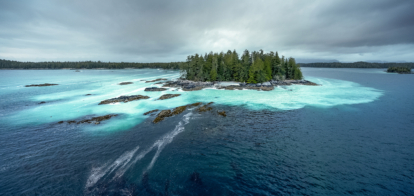One Fish to Feed Them All
Tiny but mighty, herring might be the most important fish in the ocean.
All photos by Ian McAllister
After we tied the anchor line to the edge of the kelp forest, our only job was to wait for the herring. “You’ll know when they get here,” the boat’s captain said. “Believe me, you’ll know.”
We were bobbing in a small, protected cove amid the Gnarled Islands, only a few miles south of the Alaska–British Columbia border. The Gnarlies, as they are known, are on historic Tsimshian land and are nameless in English—just a few tiny, pixelated dots on a map. From the water, the abundance of this place makes it seem like the islands, ocean, moon and tide are inhaling and exhaling in unison. The area supports a humbling plenty—salmon, eagles, orcas, whales and a clan of wolves said to be excellent swimmers. Below us, the kelp glints with a cladding of innumerable iridescent herring eggs.
The adult herring materialize 30 feet from our boat, a shimmering orb whirling underwater, catching the sunlight above. The bait ball doesn’t move so much as it just keeps growing. Soon, our boat is surrounded by herring, the bottom black with them. How many? It’s impossible to know.

A new generation of herring begins to take shape in an egg less than 2 millimeters in diameter. An individual female herring may lay over 20,000 eggs—more than 6 million eggs per square yard—but only one out of 10,000 eggs may produce an adult.
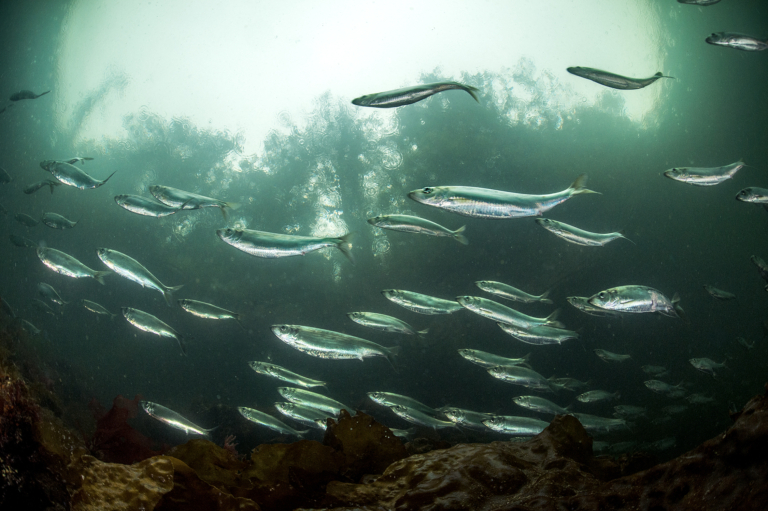
Like salmon, herring return to the same spawning areas year after year. Unlike salmon though, many generations of herring spawn together. Older fish hold essential hereditary knowledge, like where and how to spawn. They pass this knowledge down to younger fish. Because the industrial herring fishery catches the largest fish, which are the oldest, it removes crucial knowledge from the population. Some experts say this explains why herring no longer spawn in many previous locations—they have forgotten where to go.
The salmon arrive suddenly, angrily. Eight or 10 or 12 appear from nowhere, flying in an underwater formation and smashing into the bait ball. Fish near the surface leap out of the water and rain down, back into the sea. The ball shape-shifts, whirling all the time, but the salmon are back for another pass, swimming with a speed and precision that’s unexpected. It’s only then we remember to grab our fly rods and lob a baitfish imitation into the fray, praying for a grab but fearful of what would happen after.
It’s not just the salmon who are hungry. Herring are feed for everything here. Flocks of gulls patrol between islands, dive-bombing schools. Eagles perch on escarpments, awaiting the scraps and the low tide. A group of humpback whales herds herring into a small cove and begins bubble-net feeding. When the whales surface and exhale, their breath smells of both the sea and the herring—a partially digested fish belch. But where, I wonder, are the seals and sea lions? With this much food for the taking, they should be everywhere. Only then do I learn about the hard-swimming wolves who have perfected the art of sneaking up on a beach-dozing seal.
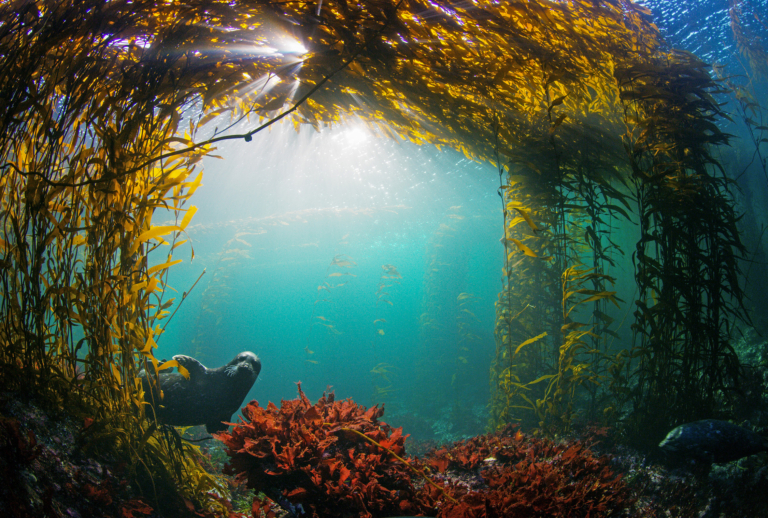
A harbor seal finds shelter from killer whales in a forest of kelp. From the smallest animals to the largest, countless species on the Pacific coast owe their existence to the abundance of herring. Fundamentally changing the way humans manage herring is needed. Taking an ecosystem-based approach, one that recognizes and allocates for the myriad nonhuman species that directly rely on herring, is a first step toward building a sustainable fishery and allowing for the recovery of Pacific herring.
After witnessing millions of herring being eaten by thousands of salmon, uncountable scores of birds and dozens of whales, we’re overwhelmed by the abundance of a place like the Gnarled Islands; so it’s difficult to fathom that herring stocks in northern Pacific waters have been in decline for more than 100 years due to overfishing. It’s been equated to the clear-cutting of the ocean.
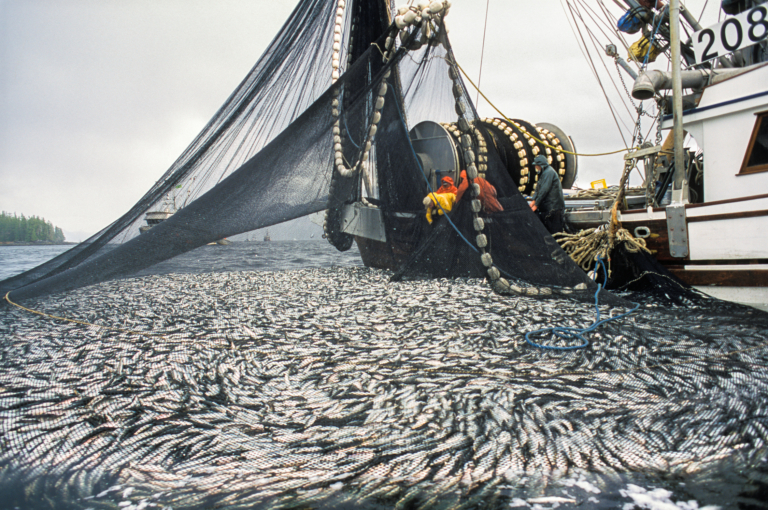
Herring populations have suffered severe declines from California to Alaska after a century of industrial-scale fishing. Along the coast of British Columbia, once a herring stronghold, four out of five major herring fisheries are now closed due to overfishing. It remains unclear if these populations will ever recover. Today, herring eggs are sold to the sushi markets in Asia, but the rest of the body is processed into fish meal to feed fish farms or turned into pet food and garden fertilizer. Ignoring the disproportionate role this forage fish plays in supporting coastal communities and ecosystems, government fishery managers continue to allow humans to take the majority of herring each year.
According to archaeological records, Pacific herring, Clupea pallasii, have been fished in the northwest Pacific Ocean for more than 10,000 years. In Russia, they were known as “holy bread.” In Japan, the Ainu people called them “God fish.” Along the northwest coast of North America, they were the “feed for everything.” As fuel and a foundation species to the whole marine food web, herring are crucial for what’s known as their ecosystem service: providing food for aquatic species, indicating water quality and overall ecosystem health, and giving nutritional, social and cultural benefits to humans. This tiny silvery glint is, to many, the most important fish in the sea.
Historically, Indigenous populations in North America harvested herring up to two months before spawn. The fish could be harvested and then eaten fresh, smoked or dried, or rendered into oil. The herring eggs that covered the seaweed, eelgrass and hemlock boughs, carefully placed by gatherers to catch and collect the eggs, are traditional delicacies and still harvested by Native communities today.
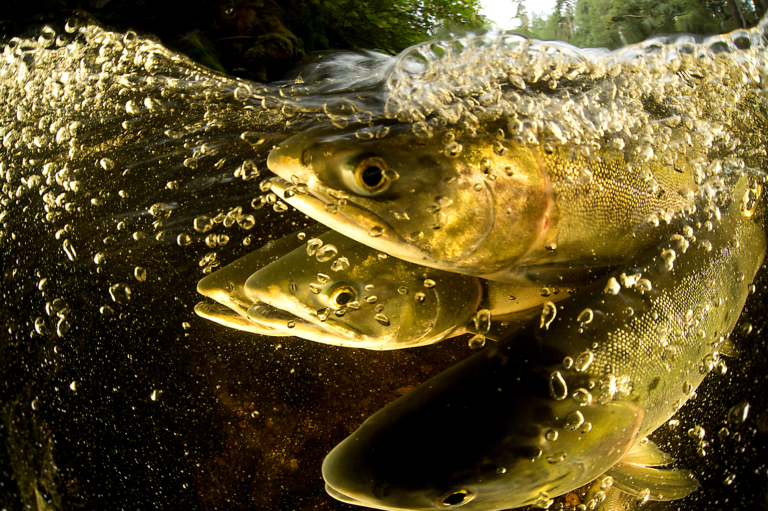
Pink salmon migrate to their natal river to start a new generation of salmon. From the time juvenile salmon leave their rivers of birth, they rely on the abundance of herring for their survival. Archaeological records from up to 10,700 years ago show that herring were more abundant and widespread than they are today. In 171 archaeological sites stretching from Puget Sound into Southeast Alaska, herring bones made up almost half of all fish bones, on average, and were found at 99 percent of sites. In some parts of British Columbia’s coast, herring were likely a more important food source than Pacific salmon.
The tipping point for Pacific herring traces as far back as the 1870s, when commercial interests seized the herring fishery and built a rendering plant in Southeast Alaska. After millennia of sustainable use, the underpinnings of an ecosystem and culture were about to be decimated. Used for food, the Alaskan harvest in 1878 was 30,000 pounds (15 tons). By the 1920s, motorized seine boats, new rendering plants and new markets for bait, fertilizer and feed sent the herring populations plummeting. In 1937, 125,000 tons of herring were processed in Alaska’s reduction plants. By 1939, the population had collapsed, and Alaska prohibited all herring fishing except for bait. The respite didn’t last long.
Both Canadian and American fishing regulations were based on shaky science, had abandoned local and traditional knowledge, and were hell-bent on extracting everything they could—damn the salmon, damn the whales, damn it all. After decades of global overfishing, herring populations collapsed in the 1960s.
For decades, a sad cycle repeated itself: Herring populations collapsed every few years and in multiple locations, at times teetering on the knife-edge of their capacity to rebound.
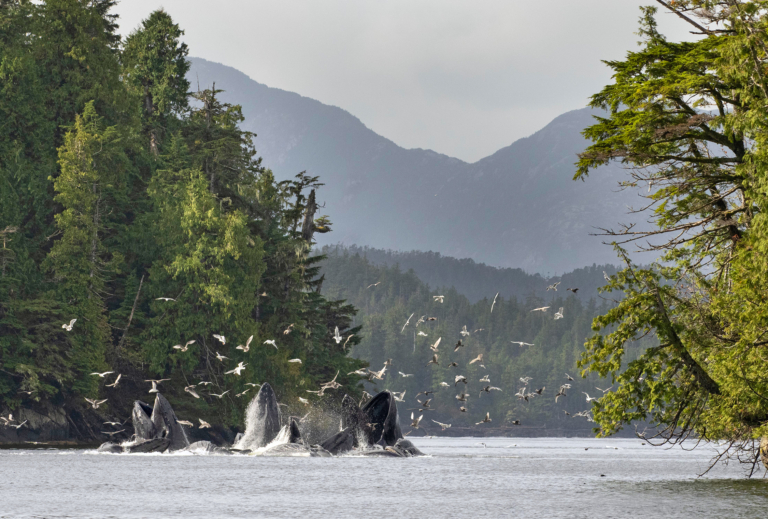
Humpback whales forage for herring in the Great Bear Rainforest by deploying one of the most fascinating cooperative feeding methods found on Earth. The group first locates fish deep below the surface. Then, together they dive underneath their prey, blowing a bubble-net—a perfect circle—around the fish. With the trap set, the whales begin a piercing vocalization that can be clearly heard above water. One theory is that the vocalization is so loud outside the bubble-net that it forces the prey inside the acoustic bubble. Then the final feeding calls are heard, and the whales, with mouths wide open, rise to the surface, hoping the elaborate strategy pays off. This group of around 12 individuals would bubble-net feed about every five minutes.
Unfortunately for the herring, a new market for their sac roe—kazunoko—emerged in Japan in the 1970s. Since Japan’s stocks had crashed due to overfishing, the harvest shifted to North America. Japanese and Russian trawlers did the heavy lifting and, once again, herring were in serious trouble. Processors stripped the fish of the valuable egg sacks while the rest was ground into feed, often pressed into pellets for net-pen hatchery salmon.
In 2021, Alaska set its sac roe harvest level at 33,000 tons. Keep in mind there was no sac roe harvest in 2018 or 2019 in Alaska. And in Canada, four of the five commercial herring fisheries are now closed. In a recent report, the conservation group Pacific Wild called for a closure of the herring kill fishery in British Columbia: “Without immediate, drastic conservation measures, which must include a complete moratorium on the kill fishery—at least until populations have rebounded and science has had a chance to catch up—Pacific herring will remain in peril as will every other species in the marine food chain that relies on herring for its survival.” Numerous Native communities up and down the coast have been asking for the same thing for years. In many cases, tribes have had little response, though some have sought legal remedy in British Columbia. The intermittent closures in British Columbia and Alaska have not stabilized populations as herring can take a decade to recover.
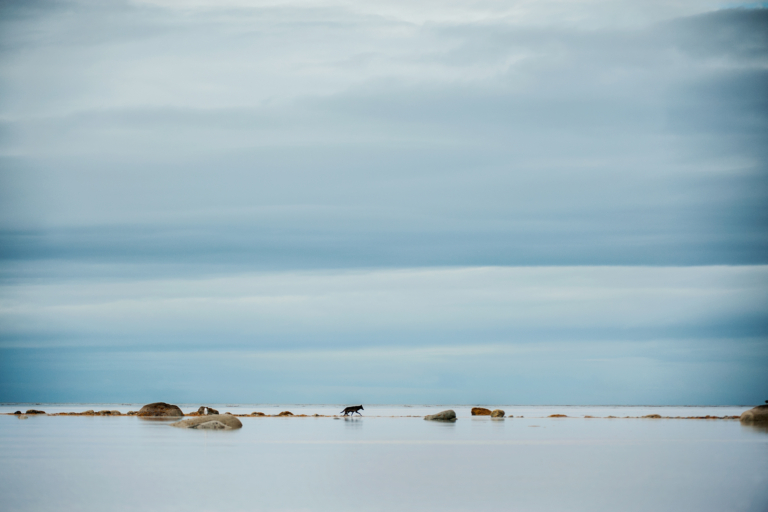
A lone wolf returning from a feast of herring eggs revealed at low tide. In many parts of the north Pacific, coastal wolves derive the majority of their diet from the ocean, including eating herring eggs and a host of other species that depend on the adult fish.
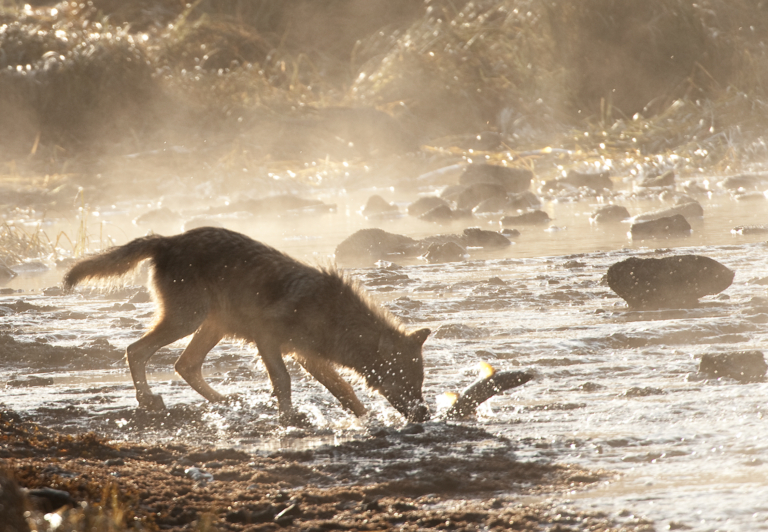
Early-morning salmon fishing for a coastal wolf.
It’s easy to feel the flush of abundance when you’re chucking flies into bait balls of herring while salmon are eating and, 100 yards away, whales are breaching. But abundance is a tricky thing, and herring are slippery things to count. Was that afternoon fishing in British Columbia an illusion? A look back into the past? A reminder of how herring connects everything? Probably all three. But what is incontrovertible is that overfishing is the root of the herring’s troubles. The science is clear: Most of our exploited herring populations collapsed in the 20th century, and overfishing is implicated as the most prevalent cause.
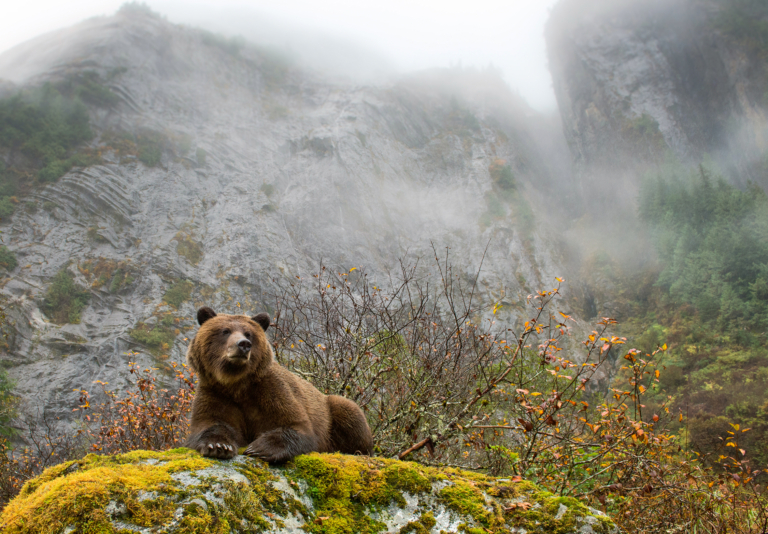
Herring play a vital role in the coastal ecosystem, transferring energy from plankton to bigger animals, like this coastal grizzly bear. Herring are important food for fish like Chinook and coho salmon, lingcod, Pacific halibut and Pacific whiting. Marine mammals also rely on herring, including humpback whales, dolphins, porpoises, sea lions and seals. Millions of seabirds feed on spawning adults and eggs. Bears and wolves migrate down to the tide line during and after the spawn to eat herring eggs. Even plants that grow on beaches near herring spawning sites contain nutrients that come from the fish. As herring become smaller and less common over time, there is less food to go around. A complete collapse of herring populations would cause ecosystem-wide changes.
For more than two decades, writer, photographer and filmmaker Ian McAllister has worked and lived on British Columbia’s northwest coast, documenting the flora and fauna of this remote rain forest. In these photos, McAllister presents a singularly delicate, symbiotic ecosystem. “Miraculously, this coastline is intact,” he says. “But these aren’t museum pieces. This is real life out here. This is what we stand to lose. Indigenous cultures depend on this for their very survival. This isn’t removed from humanity. It’s very much a part of it. We have to protect this place while respecting that there are still communities living sustainably here.
“There’s no such thing as four seasons there. There are countless seasons, and some might only last a week or 10 days,” he explains. “You realize how fragile and interconnected this existence is. We see things unravel so quickly when there are even small changes. These photographs might give an idea of unbridled abundance—but everything is hanging by a thread. It’s all a web. When you unravel one little thread in the web, everything else begins to unravel rather quickly.”
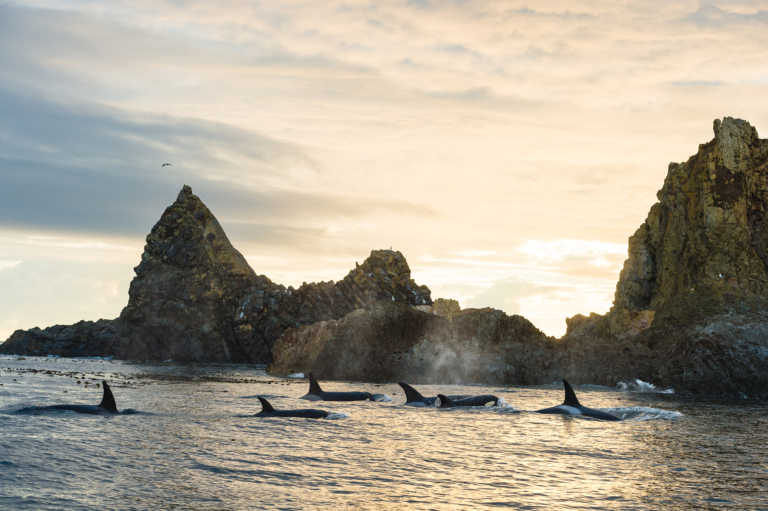
Herring are truly mighty little fish, ensuring the smallest and largest animals on the coast are provided for. These transient killer whales are on the hunt for seals and sea lions off the coast of British Columbia. More and more species—from Chinook salmon to resident killer whales—are added to the endangered species list as herring numbers continue to decline. A multiyear moratorium on industrial herring fishing would be the first step toward rebuilding their populations throughout the eastern Pacific.
